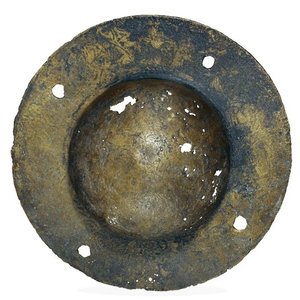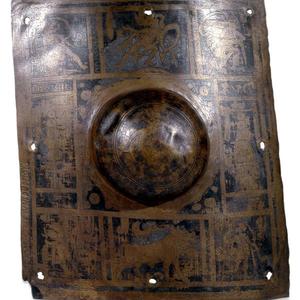Umbo
An umbo (Latin: umbo "projection, bulge") is a metal attachment of hemispherical or conical shape placed in the center of a shield, protecting the warrior's hand from blows. On the inner side of the shield under the umbo, there was often a handle for the warrior to hold the shield. Sometimes the umbo had a pointed shape, allowing the shield to be used offensively. The umbo also had a decorative function: Celtic shields, for instance, were found adorned with multiple umbos.
Shields with an umbo were widely used from the Bronze Age to the late Middle Ages, as a more expensive and reliable option compared to simple wooden shields. The method of holding the shield by the handle in the middle significantly influenced combat tactics: in individual fencing, it allowed for active parrying and attacking, and in a formation, it enabled the creation of a dense, continuous shield wall.
Umbos were made from iron, bronze, and wood. Iron and bronze umbos were the most common due to their strength and durability. Wooden umbos were used less frequently as they were less strong and durable but could serve as a temporary or more affordable option.
Umbos were often decorated with various patterns and inlays, adding decorative value. For example, Celtic shields sometimes had multiple umbos adorned with engravings or inlays of precious metals and stones. These decorative elements not only enhanced the aesthetic value of the shield but also indicated the status and wealth of the owner.
The umbo played an important role in combat, allowing the warrior to effectively defend and counterattack. In close combat, the umbo could be used to strike the opponent, making it not only a defensive but also an offensive element of armament. In infantry formations, the umbo enabled the creation of a continuous line of defense, enhancing protection against arrows and other projectiles.




